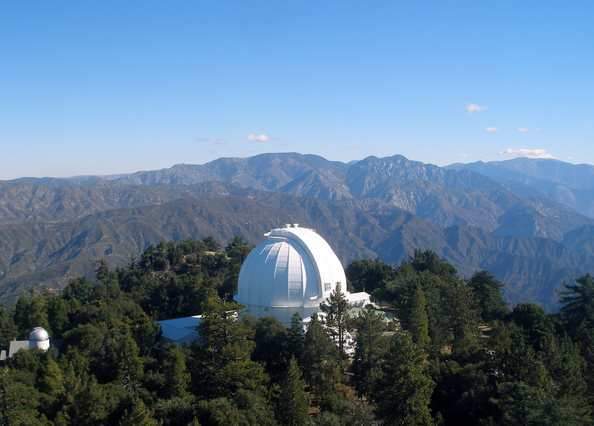History of Telescopes
The first telescopes were little more than hand-held wooden tubes, but they allowed Astronomers to discover mountains on the Moon and Moons around Jupiter. Today's giant telescopes let us see billions of light years into the far reaches of Space.
Like eyes, telescopes collect light and focus it to create an image. Unlike our eyes, however, telescopes can their sights into tiny targets and can add together the light they recieve over a long period. The bigger a telescope is, the more light it can collect and the sharper the image. With a large telescope, we can zoom on distant galaxies or volcanoes on Mars. The first telescopes used glass lenses, but big lenses bend under their own weight, so astronomers switched to mirrors to make telescopes bigger. In the largest telescopes, dozens of segments are arranged together to form one giant, curved mirror. Earth's atmosphere blurrs our view of space, so professional telescopes are build on mountains where the air is dry and still, or the telescopes are launched into Space like Hubble Space Telescope
The History of Telescopes can be traced to before the invention of the earliest known telescope, which appeared in 1608 in the Netherlands, when a patent was submitted by Hans Lippershey (fig2).
He was an Eyeglass Maker, although he did not recive his patent, the news of the invention soon spread across Europe.
Johaness Kepler (fig3) described how a far useful telescope could be made with a convex objective lens and a convex eyepiece lens. By 1665, Astronomers such as Christiaan Huygens
were buliding powerful unwiedly Keplerian Telescopes with compound eyepieces.
Isaac Newton is credited with building the first reflector telescope in 1668 with a design that incorporated a small flat diagonal mirror to reflect the light to an eyepiece mounted on the either side of the telecsope. Laurent Cassegrain in 1672 described the design of a reflector with a small convex secondary mirror to reflect light through a central hole in the main mirror.
The Acromatic Lens, which greatly reduced colour abberations in objective lenses and allowed for shorter and more functional telescopes, first appeared in a 1733 telescope made by Chester Moore Hall, who did not publisize it. John Dollond learned of Hall's invention and began producing telescopes using it in commercial quantities starting in 1758.
Important developments in the reflecting telescopes by John Hadley's production of larger paraboloidal mirrors in 172; the process of silvering glass mirrors was introduced by Leon Foucault in 1857; the adoptation of long lasting aluminized coatings on reflector mirror in 1932.
The Ritchey Chretien variant of Cassegrain Reflector was invented around 1910, but not widely adopted until after 1950 many modern telescopes such as the Hubble Space Telescope use this design, gives a wider field of view than classic Cassegrain. During the period 1800-1900, reflectors suffered from problem with Speculum metal mirrors, and a considerable number of great reflectors were build from 60 Cintimetre to 1 Metre aperture culminating in the Yerkes Observatory refractor in 1897 however starting from the early 1900's a series of even larger reflectors with glass mirrors were build, including the Mount Wilson 60 inch (1.5) the 100 inch (2.5) metre Hooker Telescope (1917) and the 200 inch (5 metre) Hale Telescope(1948); essentially all major research telescopes since 1900's were reflectors. A number of 4 metre class (160) inch telescopes were build on higher altitude sights including Hawaii and the Chilean Desert in the 1975-1985 era.
The Development of the Computer controlled alt-azimuth mount in the 1970s and active optics in the 1980s enabled a new generation of even larger telescopes, starting 10-metre (400 inch) Keck telescopes in 1993/1996, and a number of 8-metre telescopes including the ESo Very Large Telescopes, Gemeni observatory and Subaru Telescope.
The era of radio telescopes (along with radio astronomy) was born with Karl Guthe Jansky's serendipitous discovery of an astronomicalradio source in 1931. Many types of telescopes were developed in the 20th century for a wide range of wavelengths from radio to gamma-rays. The development of space observatories after 1960 allowed access
to several bands impossible to observe from the ground, including X-rays and longer wavelength infrared bands.
A telescope uses a lens or a mirror to collect light from the distant objects and focus it create an image







Comments
Post a Comment